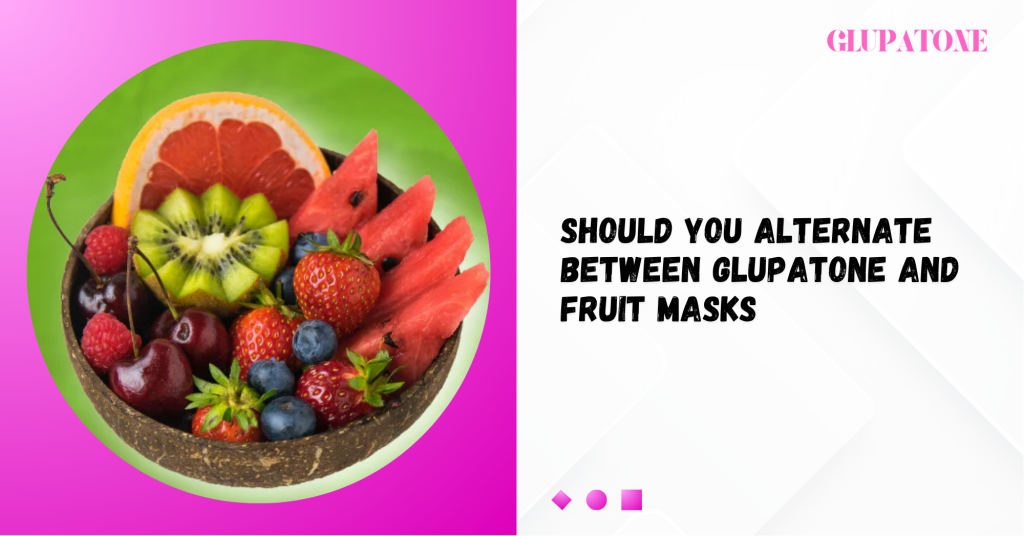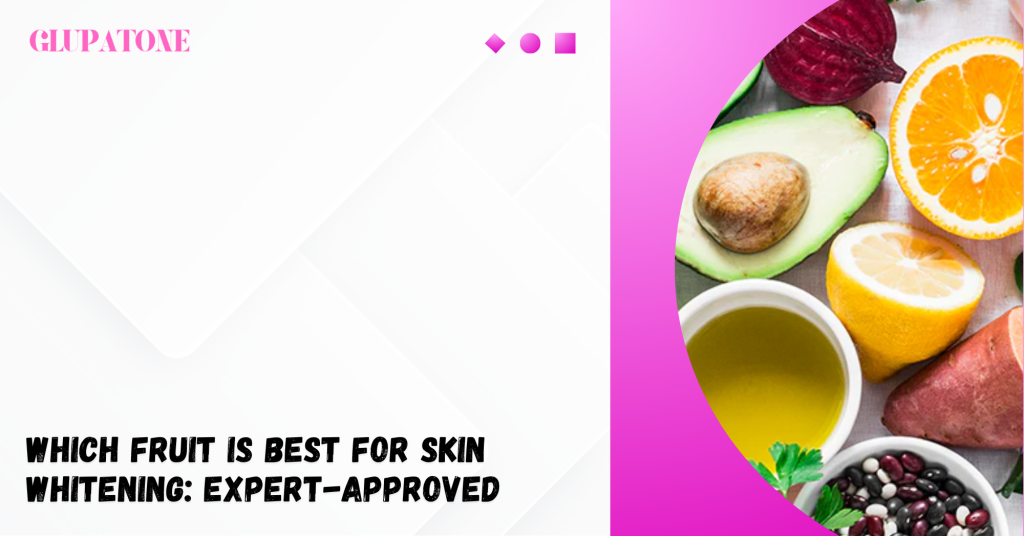Introduction to Fruits and Skin Whitening
Fruits have long been cherished in both traditional and modern skincare routines due to their rich supply of skin-loving nutrients. Whether consumed through diet or applied directly, fruits can significantly help in enhancing skin brightness and even tone — all without harsh chemicals.
What Makes Fruits Effective for Brightening Skin
Which Fruit Is Best for Skin Whitening? Well, fruits are naturally rich in vitamin C, AHA (alpha hydroxy acids), enzymes, and antioxidants. These nutrients can help:
- Reduce melanin production
- Lighten pigmentation and dark spots
- Promote collagen production
- Protect against environmental damage
This combination leads to smoother, brighter, and more even-toned skin over time.
Role of Diet and Topical Use in Skin Whitening
Consuming fruits provides long-term benefits by nourishing the skin from within, while applying them topically gives faster surface results. For example:
- Eating oranges or papaya boosts collagen and antioxidant levels.
- Applying fruit masks helps exfoliate dead skin and lighten blemishes directly.
Using both dietary and topical approaches together — along with dermatologist-approved products like Glupatone — can significantly amplify your skin-brightening journey.
Reveal a Brighter, More Radiant You—Experience Glupatone Today!
Glow Naturally! Achieve Even Skin Tone with the Power of Glupatone
Top Fruits for Skin Whitening
Papaya: The Enzyme-Rich Skin Brightener
Papaya contains an enzyme called papain, which acts as a natural exfoliant. It breaks down dead skin cells and boosts cell turnover, helping to fade dark patches and pigmentation.
Why papain helps fade dark spots and uneven tone:
- Removes dead skin and unclogs pores
- Brightens dull complexion over time
- Helps smooth rough skin texture
Best ways to use papaya on skin or in your diet:
- Topical: Mash ripe papaya and apply as a mask for 10–15 minutes.
- Diet: Eating papaya supports digestive health, which indirectly benefits skin clarity.
Orange: Loaded with Vitamin C
Oranges are a powerhouse of vitamin C, known to brighten skin, fade pigmentation, and improve skin elasticity.
How citrus boosts collagen and fights pigmentation:
- Neutralizes free radicals that cause dullness
- Encourages new collagen production for firmer, clearer skin
- Reduces dark spots and post-acne marks
Using orange peels and juice in skincare:
- Peel powder + yogurt makes an excellent exfoliating mask
- Orange juice + honey can brighten skin when applied for 10 minutes
Lemon: Natural Bleaching Agent
Lemon juice contains citric acid, which has mild bleaching properties. It can help lighten pigmentation but must be used carefully.
Benefits and cautions of lemon on skin:
- Lightens dark spots and acne scars
- Evens skin tone over time
- May cause sensitivity or stinging — dilute before use
Tips for safe use in DIY remedies:
- Always dilute with water, honey, or aloe vera
- Never step into sunlight after applying lemon on your skin
- Use only 1–2 times a week to avoid over-exfoliation
Pairing Tip: Use lemon masks in the evening, and follow up with Glupatone cream for added hydration and skin tone balance.
Tomato: A Fruit Packed with Lycopene
Tomatoes are not just a kitchen essential — they’re packed with lycopene, a powerful antioxidant that naturally reduces pigmentation and protects the skin from UV damage.
Brightening and Anti-Aging Benefits of Tomatoes
- Fades dark spots and discoloration
- Shrinks pores and balances oil production
- Delivers anti-aging effects with regular use
Tomatoes are especially helpful for dull, tired skin that’s been exposed to pollution or the sun.
Simple Ways to Apply Tomato Juice or Pulp
- Rub raw tomato slices on your face for 5–10 minutes, then rinse.
- Mix tomato pulp with honey or yogurt for a soothing and brightening mask.
Strawberry: Rich in Alpha Hydroxy Acids
Strawberries are a rich source of alpha hydroxy acids (AHAs), particularly salicylic acid — making them excellent for exfoliating and clarifying the skin.
How Strawberries Exfoliate and Refresh Skin Tone
- Gently remove dead skin cells
- Improve uneven tone and texture
- Help reduce acne marks and clogged pores
Best Combinations for Masks and Serums
- Strawberry + yogurt = brightening and cooling
- Strawberry + lemon juice = for oily skin (use cautiously)
- Strawberry + aloe vera = perfect for sensitive skin
Important: Follow up with Glupatone emulsion after using any strawberry mask to nourish your skin and extend the whitening benefits without over-drying.
Pomegranate: Deep Brightening and Repair
Pomegranate is rich in ellagic acid and antioxidants that help suppress melanin production and rejuvenate sun-damaged skin.
How It Helps Reduce Melanin and Repair Sun Damage
- Targets dark spots, tanning, and dullness
- Boosts skin regeneration
- Provides long-lasting glow and smoothness
Ways to Consume and Apply Topically
- Drink pomegranate juice daily for antioxidant support
- Apply mashed seeds with rose water as a refreshing, brightening face pack
Combine it with Glupatone in your skincare schedule to ensure both internal and topical treatment for skin clarity.
Fruits vs. Skin Brightening Creams Like Glupatone
While fruit masks and juices are natural and effective to some degree, they can take longer to show results and may not be suitable for all skin types.
Are Natural Remedies Enough?
Natural fruit-based treatments:
- Work slowly
- May cause irritation if misused
- Have less control over concentration and consistency
That’s where Glupatone excels — it offers a safe, balanced formulation of glutathione, vitamin C, kojic acid, and other skin-brightening ingredients that are tested for efficacy.
How Glupatone Complements Fruit-Based Skincare
When to Combine Fruits with Clinically Formulated Products Like Glupatone for Enhanced Results
- Use fruit masks in the evening for exfoliation
- Apply Glupatone emulsion or cream afterward for hydration and whitening
- Avoid layering raw fruits directly with Glupatone — instead, alternate them
This approach helps reduce pigmentation more effectively without overwhelming your skin.

Should You Alternate Between Glupatone and Fruit Masks?
Yes — alternating is the safest and most effective way.
Best Practices for Integrating Both Into Your Routine Safely
- Example Routine:
- Day 1: Apply a fruit mask (e.g., papaya or tomato)
- Day 2: Use Glupatone cream in your AM/PM skincare
- Day 1: Apply a fruit mask (e.g., papaya or tomato)
- Always patch test new ingredients
- Use sunscreen daily to protect your whitening results
How to Use Fruits for Skin Whitening
Fruits are packed with enzymes, antioxidants, and vitamins that gently brighten the skin. But to get visible results, you must use them the right way — and know when to include clinical products like Glupatone for extra effectiveness.
DIY Fruit Masks and Scrubs
Creating your own fruit-based face packs is simple and effective if you choose the right combinations for your skin type.
Popular Recipes Using Lemon, Papaya, Tomato, etc.
- Lemon + Honey: Gently bleaches and moisturizes (for oily skin)
- Papaya + Yogurt: Enzymatic exfoliation and brightening
- Tomato + Aloe Vera: Calms redness and fades dark spots
- Strawberry + Milk: For gentle exfoliation and glow
- Banana + Turmeric: Brightens dull skin and reduces spots
How Often to Use for Visible Results
Using fruit masks too frequently can irritate the skin — especially when acids like lemon or papaya enzymes are involved.
Guidelines Based on Skin Type and Sensitivity
- Normal to Oily Skin: 2–3 times a week
- Dry or Sensitive Skin: Once a week with soothing fruits like banana or cucumber
- Acne-Prone Skin: Avoid citrus-heavy mixes; use aloe-based fruit masks
Alternate your fruit mask days with Glupatone application days for optimal whitening and nourishment.
Precautions Before Using Fruits on Face
Fruits are natural, but their concentrated enzymes can be irritating or photosensitizing when used incorrectly.
Patch Testing, Sun Sensitivity, and Mixing Do’s & Don’ts
- Always do a patch test on your inner wrist or jawline before using a new fruit blend.
- Never apply citrus fruits like lemon before sun exposure.
- Don’t mix fruit acids with strong actives or Glupatone directly—use them on alternate days.
- Rinse thoroughly and follow with a gentle moisturizer or Glupatone cream.
🧴 Important: Glupatone can help soothe and rebalance the skin after fruit exfoliation, making it a great follow-up to your fruit-based treatments.
Expected Results and Timeline
Fruits are a slow and steady path to brighter skin, not a quick fix. Results depend on consistency and overall routine.
When to Expect Brighter Skin
- Initial glow: Within 1–2 weeks of consistent use
- Visible reduction in pigmentation: Around 4–6 weeks
- Even skin tone: After 2–3 months with diet + external care
Pairing fruit masks with Glupatone’s glutathione-based formula can accelerate the process and extend the glow.
Signs the Fruit-Based Routine Is Working
- Smoother, more even skin tone
- Reduced dark patches or tan
- Natural radiance without makeup
- Skin feels softer and looks refreshed
If you’re not noticing improvements after a month, it’s best to consult a skincare professional. Sometimes natural remedies need clinical support — and Glupatone may be the missing piece in your routine.
Support Healthy, Luminous Skin—Try Glupatone’s Gentle Yet Effective Formula!
Confident Skin Starts Here—Discover the Glow Within with Glupatone.
Conclusion: Choosing the Right Fruit for Your Skin
Fruits are nature’s gentle answer to dull, uneven skin tone. Whether you’re drawn to the enzyme power of papaya, the Vitamin C boost of oranges, or the soothing effects of strawberries, there’s a fruit-based solution for nearly every skin concern.
But it’s not always about going all-natural. Products like Glupatone, formulated with Glutathione, Vitamin C, and Kojic Acid, can complement your fruit-based skincare and offer faster, more consistent results. You might use fruit masks once or twice a week and apply Glupatone cream daily to maintain brightness and improve skin tone long term.
Frequently Asked Questions (FAQs)
Can I use fruit masks every day?
It’s not recommended to use them daily, especially those with citrus or exfoliating enzymes. 2–3 times a week is usually enough.
Which fruit works the fastest for skin whitening?
Papaya and lemon are often considered the quickest due to their natural enzymes and acids. However, they must be used carefully.
Can I mix fruit with Glupatone cream?
It’s better to use fruits and Glupatone separately, either on alternate days or by applying Glupatone after rinsing off the fruit mask.
Are fruit acids safe for sensitive skin?
Not always. Acidic fruits like lemon or orange can cause redness or stinging. Try gentler fruits like banana, aloe vera, or cucumber, and always do a patch test.
What fruits should I eat daily for glowing skin?
Papaya, oranges, pomegranate, and berries are excellent choices. Eating a balanced diet rich in antioxidants will help your skin from within.
Do fruits help with pigmentation and acne scars?
Yes, fruits like tomato, papaya, and pomegranate can gradually reduce pigmentation and fade post-acne marks. Pairing them with Glupatone may enhance these effects.
Can men use fruit-based whitening treatments?
Absolutely! These natural remedies and products like Glupatone are gender-neutral and suitable for anyone looking to brighten their complexion.
Latest Posts:

